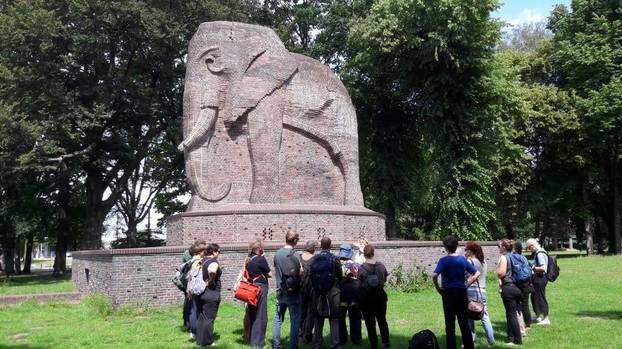
Germany is currently in the midst of intense public debates about how to deal with its colonial legacies in Africa. For quite some time, Nama and Herero activists have been demanding reparations for the Namibian genocide of 1904–1907 as well as the repatriation of human remains used by German scientists for medical and anthropological research. Meanwhile, African and German anticolonial activists are vigorously demanding name changes for streets in German cities named after colonial political and military figures. Given the serious way in which Germany has “worked through” its Nazi past over the past few decades, it seems rather puzzling that is has taken so long to confront the country’s colonial history.
In my recently published book, Letters of Stone: From Nazi Germany to South Africa (Penguin Random House, 2016), I explicitly drew on Hannah Arendt’s notion of the “boomerang” to show how the seeds of Nazi eugenics and racial hygiene were sown in the fertile soil of Germany’s colonies. In 1908, the German physical anthropologist and anatomist Eugen Fischer published his study of the “mixed-race” Rehoboth Basters in German South West Africa. This ethnographic study established Fischer’s international reputation as a leading eugenics scientist. It was also praised by Hitler after he read about it in a Munich prison in 1923. Fischer’s research highlighted the dangers of “racial mixing”, and his findings, incubated in the human laboratories of the colonies, later rebounded back to the heartland of Europe where Nazi racial laws directly impacted upon the fate of my father’s family, who were trapped in Berlin.
By the mid-1930s Fischer had become one of the Nazis’ most senior racial scientists, and from 1929 to 1942 he was the director of the prestigious Kaiser Wilhelm Institute for Anthropology Human Heredity and Eugenics (KWI-A) in Berlin. Fischer’s institute, which was funded by the Carnegie and Rockefeller Foundations in the 1920s and early 1930s, later became intimately involved in Nazi racial classification and provided the scientific justification for the introduction of infamous ordinances such as the Nuremburg Laws. Once the war began, Fischer’s institute began receiving blood samples and eye specimens from Josef Mengele’s experiments with Jewish, Roma, and Sinti twins in Auschwitz. What began as an ethnographic study of “racial mixing” in German South West Africa in 1908 had morphed into horrific experiments on inmates in a death camp in Poland.
During a recent visit to Bremen as part of a “Decolonize Bremen” workshop, I became acutely aware of how the connections between the Herero and Jewish genocides continue to be kept apart. I also learned that following World War I, when Germany had to give up its lucrative colonies in South West Africa, Cameroon, Togo, and German East Africa (now Tanzania), port cities such as Bremen experienced significant economic losses. By the 1920s the owners of Bremen trading companies were vigorously lobbying the Weimar Republic government to regain Germany’s lost colonies. By 1932 they had succeeded in establishing the notorious “African Elephant Monument” to commemorate the fallen German soldiers of the colonial wars. Bremen mercantile capitalists such as Adolf Edouard Lüderitz and Heinrich Vogelsang had been vociferous promoters of the colonization of South West Africa. After World War I, this class of Bremen business elites became ardent advocates for the return of these “African jewels”.
In front of this gigantic and grotesque red brick “African elephant”, which was transformed by anticolonial Bremen activists and scholars during the1990s into an “anti-colonial” memorial, was another small memorial site referring to the Herero and Nama genocide. Established in 2009, this counter-memorial consisted of a few rocks from Namibia’s Omaheke Desert and a small plaque with a photograph of Herero prisoners in chains. The litter and grass growing between the rocks conveyed a sense of neglect and abandonment. A handful of homeless people sat on the benches next to the two memorials.
This derelict public space provoked in me powerful feelings of indignation and outrage. How could this ragged and ramshackle memorial do justice to the Namibian descendants of the victims of General von Trotha’s extermination order, culminating in the deaths of tens of thousands of Herero in the Battle of Waterberg in the Omaheke Desert? Dwarfed by the giant “African elephant”, this small collection of rocks from the Omaheke Desert seemed to me to be an insult to the memory of Namibian victims of genocide. I thought to myself that this would never have been acceptable had the victims been Jews! To make matters worse, this is one of the only memorials to the Namibian genocide in Germany.
This small and neglected “anticolonial” memorial appeared to be hopelessly inadequate for the task. The source of the problem was not the activists who had struggled to establish this memorial in the face of official opposition and indifference, but rather the Bremen local authorities and the national government that to this day has not provided the resources for an adequate commemoration of the Namibian genocide.
This visit to the two memorials revealed to me the deep and troubling entanglements of German colonialism and the making of the successful modern, commercial city of Bremen. It also drew attention to the ongoing difficulties of publicly acknowledging the Namibian genocide.
Steven Robins is a Professor in the Department of Sociology and Social Anthropology at Stellenbosch University, South Africa, and will be speaking at RLS events in Berlin and Erfurt over the course of September. A version of this article originally appeared in the Bremen local edition of die tageszeitung.